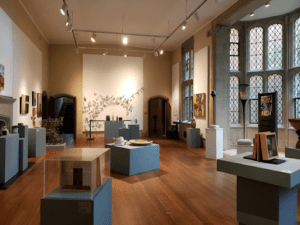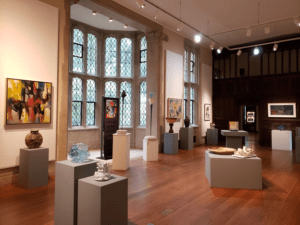Margaret Richardson
VA Made: ‘Med
iation Across Media’ at the Branch Museum of Architecture and Design in Richmond, Virginia (July 17 – September 13, 2020) offers a unique opportunity to realize relationships between divergent media and expand one’s perspective of ‘things’.
Co-organized by Howard Risatti and Steven Glass, this ambitious exhibition features works circa 1955-2019, from over 30 artists grouped into ‘tableaux,’ an apropos principle for dissolving boundaries. Two-dimensional works provide backdrops for three-dimensional objects, staged to ‘speak’ individually, among groupings, and with contexts past and present. In juxtaposition, commonalities of form and content are realized while various dual themes emerge, providing multivalent ‘pictures’ to ponder.
Context is key to this exhibition, which debuted in Staunton at the Beverley Street Studio School. Its intimate ‘white cube’ created a contemplative viewing space, while the Branch Museum’s Tudor-revival details add complexity. Here, 13 tableaux define the perimeter of the room and four tableaux occupy its center. Numbered and titled but without linear order, tableaux invite myriad cross-references.
At one end of the gallery, ‘Tableaux #9 ‘Form in Space Biomorphic/Geomorphic’ commands attention, providing direction and possibility. Attached to the wall, Sukjin Choi’s whimsical Path, a vortex of blue and white ceramic shapes, like birds or waves, forms a dramatic pattern around conventional ceramic vessels of varying shapes by David Crane, Jeff Vick, Catherine White, and Steven Glass. Showcasing what ceramics can ‘do’, they highlight multiple ‘paths’ of display and meaning.
Black window-panes define the adjacent wall, offering another framing device for four abstractions and accompanying objects. Maurice Bond’s slashing brushstrokes highlight related colors, textures, and ‘Directional Intentions’ in John Jessiman’s wood-fired clay vase, while swirls in Stephen Addiss’s Sumi ink painting echo similar ‘Consequential Gestures’ marking Steven Glass’s container, revealing action painting across media and cultures. Similarly, Ray Kass’s smoke-made painting is framed by Robert Barnard’s bronze-looking wood-fired ceramic and Barbara Dill’s weathered wood-turned bowl. As the title suggests, each are ‘transformed’ by wood/fire/smoke and other associations. These tableaux flank Jaime Pelissier’s hand-carved stone and metal sculptures and Susan Iverson’s tapestry within the bay window. Like figures, totems or furniture, their geometric shapes reference modern abstraction and ‘primitivism’. Together, these tableaux collapse time, space, and distances between fine art and craft.
Nearby and on the adjoining wood-paneled wall are other formal connections. Paolo Arao’s colorful grid painting echoes its surroundings, providing a window ‘into’ Lydia Thompson’s abstract collage, ‘Dwelling with Pathway’. Back-to-back on a pedestal, viewers travel between them to notice ‘Parallels in Form and Content’. Javier Tapia’s abstract watercolor provides a colorful complement to Cindy Neuschwander’s vibrant wooden bowl, while ‘Line in and out of Space’ is found between Andrea Donnelly’s framed fiber piece and Jiwan Joo’s ceramic Cubes. Threading or ancient Korean inlay produce minimalist effects, conflating modern formalism and traditional handicraft.
Other tableaux juxtapose natural and human design, connecting through subject. Various media allude to landscape. Below Jason Hackett’s four multidimensional plates capturing stark desert contrasts, Joan Elliott’s nuanced oil painting depicts foliage against a momentary red-orange sky. In comparison, one makes the other seem more real or abstract. On a pedestal nearby, Jim Meyer’s stone and felt necklace lies boxed in front of Andras Bality’s oil painting of waves and rocks at Gull Rock, Monhagen, ME. With this backdrop, a necklace becomes rocks on a beach, challenging jewelry’s conventions. Propped behind them, Wayne Fitzgerald’s shadowbox, Construction#1 – A Sacred Tree, contains a wooden twig placed to appear as a tree in an empty room. Painted and real shadows and objects reveal nature, literal and constructed.
Two other landscape-themed tableaux suggest human and natural decay and regeneration. In ‘Evolution/Dissolution Form/Anti-Form’, Kiara Pelissier’s wavy glass sculpture, Dark Aqua Crumple, beside Randy Edmonson’s jagged porcelain, Winter landscape, evoke glaciers melting, breaking, and combining anew. In contrast, Brooke Hine’s porcelain sculpture looks like hollow, bleached bones or branches in the Southwest when paired with Adam Welch’s burnt-orange stoneware.
Back on the wall are human constructions. Uniting architectural form and space, Kass’s expressionist watercolor of skyscrapers intermixes with neutral-colored constructions – Fitzgerald’s disquieting Ladder Still Life, Cindy Myron’s machine-like tangle of building parts; Dale Quarterman’s Funk-y clay sculpture of a precariously-perched Cliff House. Their angled shapes, ominous shadowing, and skewed perspectives all suggest something amiss.
Serendipitous ‘Color and Textural Coincidences’ are also discovered between Chuck Scalin’s abstract photograph and Choi’s green-glazed ceramic. Despite its flatness, Scalin’s up-close street scene captures the raised textures and blurry contours of sidewalk tread and spray paint. Behind Choi’s fuzzy creature, one reads something similarly organic in Scalin’s found images.
Similar imaginative leaps are made in a chair-themed tableau. Representational paintings by Diego Sanchez and Valerie Hardy, another construction by Fitzgerald, and a mixed-media sculpture by Marty Johnson suggest multiple personalities with chairs. Colorful, solemn, unstable, or fantastic, their simple subject becomes anthropomorphic and beyond functional.
This complex process of signification is encapsulated in two final tableaux over the fireplace. Susan Svendsen’s acrylic and collage on pigment print embodies themes implied in other groupings. In Out West, big sky, flat plains, and distant mountains are interrupted by a billboard, and collaged elements fragment the ground and blow through like tumbleweed. Instead of advertising, the sign depicts another natural scene, blocked by other scenes and shapes. ‘A Tableau Within a Tableau’, the deceptive representation references the conundrums raised by Magritte’s Human Condition and this exhibition.
 Below is in memoriam to Ken Winebrenner (1941-2016). Described as “a wonder with tools and materials” and a broad experimenter with an “adventurous” sense of design, Winebrenner “always had something to say…that mattered.”1 Displaying painterly glazes and a range of techniques, his ceramic creations intersect with other tableaux. They include containers that are not completely functional, allusions to natural forms and human-made de/constructions, and playful references to other genres, such as a minimalist-inspired Brown Cube. Reveling in the medium while expanding its possibilities, Winebrenner’s works provide a poignant summary to this exhibition. Individually and grouped, these ‘things’ compel us to reconsider our assumptions, look for unity within diversity, and pause and think. Like Winebrenner, they have much to say that matters.
Below is in memoriam to Ken Winebrenner (1941-2016). Described as “a wonder with tools and materials” and a broad experimenter with an “adventurous” sense of design, Winebrenner “always had something to say…that mattered.”1 Displaying painterly glazes and a range of techniques, his ceramic creations intersect with other tableaux. They include containers that are not completely functional, allusions to natural forms and human-made de/constructions, and playful references to other genres, such as a minimalist-inspired Brown Cube. Reveling in the medium while expanding its possibilities, Winebrenner’s works provide a poignant summary to this exhibition. Individually and grouped, these ‘things’ compel us to reconsider our assumptions, look for unity within diversity, and pause and think. Like Winebrenner, they have much to say that matters.
1 Obituary of Daniel “Ken” Winebrenner, Richmond Times Dispatch, October 23, 2016.
Volume 35 no. 1 September / October 2020


Thanks for the thoughtful thorough review, Andras Bality